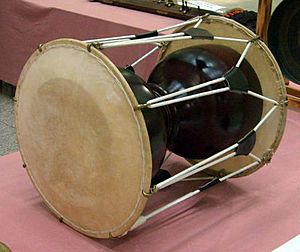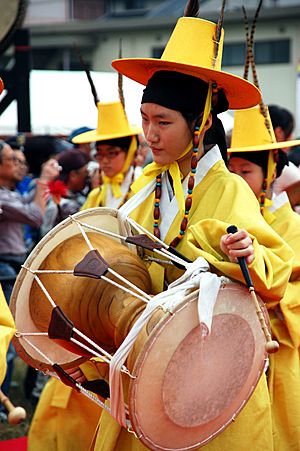Janggu facts for kids
| Janggu | |
 |
|
Quick facts for kids Korean name |
|
|---|---|
| Hangul |
장고 or 장구
|
| Hanja | |
| Revised Romanization | janggo or janggu |
| McCune–Reischauer | changgo or changgu |
The janggu (also called janggo) is a special drum from Korea. It looks like an hourglass. This drum has two different heads that make unique sounds. One head makes a low sound, and the other makes a higher sound. When played together, these sounds are believed to show the harmony between a man and a woman.
Contents
History of the Janggu
The first time we see the janggu is in ancient Korean art. It appears on a bell from the Silla period (57 BC–935 AD). You can also spot it in a painting inside a tomb from the Goguryeo period (37 BC–935 AD).
The oldest written records about this hourglass-shaped drum are from the Goryeo period. King Munjong (who ruled from 1047 to 1084) used it as a drum for soldiers in the field. Back then, people even used a special word, janggu-opsa, for someone who played or taught the janggu.
How the Janggu is Made
The janggu has a hollow body shaped like an hourglass. It can be made from different materials. These include porcelain, tile, metal, or wood. Sometimes, it's even made from a gourd or tinned metal sheets.
The most popular woods for making a janggu are poplar and paulownia. Paulownia wood is often chosen because it is very light. It also helps the drum make beautiful, clear sounds. This is because paulownia is great for resonating, which means it vibrates well to produce sound.
The Middle Part: Jorongmok
In the middle of the hourglass-shaped body is a round tube called the jorongmok. This tube connects the left and right sides of the drum. The size of the jorongmok is very important for the drum's sound.
- If the tube is wider, the drum will make a deeper, huskier sound.
- If the tube is narrower, the drum will make a harder, snappier sound.
The Drum Heads
The janggu has two drum heads, one on each open end. These heads are made of animal skin. They are stretched over metal hoops and held tightly by ropes.
- The left drum head is called the book side. It is covered with a thick skin from a cow, horse, or deer. This side makes deep, low tones.
- The right drum head is called the chae side. It is covered with horsehide. This side makes higher tones.
Beating Sticks: Chae
To play the janggu, musicians use two different kinds of beating sticks, called chae.
- The gungchae looks like a small hammer or mallet. It has a round head. The handle is often made from bamboo root that has been boiled and straightened. The head can be made from hard wood like birch or even antler. Today, some gungchae are made from plastic, especially for beginners.
- The yeolchae is always made from bamboo. It is a thin, flexible stick.
Playing the Janggu
The janggu can be played in different ways. Sometimes, it is placed on the floor, especially for traditional sanjo music. Other times, performers carry it with a strap over their shoulder. How a performer carries the janggu can depend on their personal style or where they are from.
The janggu is often used as an accompanying instrument. This means it plays along with other instruments or singers. It is very flexible and can create many complex rhythms. A performer can use both their hands and the sticks to play. This allows them to make a wide range of sounds and tempi (speeds).
The janggu can create deep, full sounds, or soft, gentle ones. It can also make menacing sounds, and play fast or slow beats. All these different sounds help to match the mood of the music and the audience. Sometimes, performers even dance while playing, moving their shoulders up and down with the rhythm.
See also
 In Spanish: Janggu para niños
In Spanish: Janggu para niños



